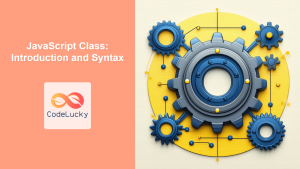JavaScript, originally designed as a prototype-based language, has evolved significantly over the years. With the introduction of ES6 (ECMAScript 2015), JavaScript embraced a more traditional class-based object-oriented programming (OOP) syntax. This addition has made it easier for developers coming from class-based languages to work with JavaScript, while still maintaining the flexibility of JavaScript's prototype-based nature under the hood.
In this comprehensive guide, we'll dive deep into JavaScript classes, exploring their syntax, features, and best practices. We'll cover everything from basic class declarations to advanced concepts like inheritance, static methods, and private fields. By the end of this article, you'll have a solid understanding of how to leverage classes in your JavaScript projects.
Understanding JavaScript Classes
At its core, a JavaScript class is a template for creating objects. It encapsulates data and the methods that operate on that data. While classes are essentially "special functions" in JavaScript, they provide a much cleaner and more intuitive syntax for creating objects and implementing inheritance.
Let's start with a basic example:
class Car {
constructor(make, model, year) {
this.make = make;
this.model = model;
this.year = year;
}
getDescription() {
return `This is a ${this.year} ${this.make} ${this.model}.`;
}
}
const myCar = new Car('Toyota', 'Corolla', 2022);
console.log(myCar.getDescription()); // Output: This is a 2022 Toyota Corolla.
In this example, we've defined a Car class with a constructor and a method. The constructor is a special method that's called when a new object is created from the class. It initializes the object's properties. The getDescription method is a custom method that returns a string describing the car.
🔑 Key Point: The class keyword in JavaScript doesn't introduce a new object-oriented inheritance model. It's primarily syntactical sugar over JavaScript's existing prototype-based inheritance.
Class Declaration vs. Class Expression
Just like functions, classes can be defined in two ways: class declarations and class expressions.
Class Declaration
We've already seen an example of a class declaration:
class Rectangle {
constructor(height, width) {
this.height = height;
this.width = width;
}
}
Class Expression
Class expressions can be named or unnamed. Here's an example of an unnamed class expression:
const Square = class {
constructor(side) {
this.side = side;
}
area() {
return this.side * this.side;
}
};
const mySquare = new Square(5);
console.log(mySquare.area()); // Output: 25
And here's a named class expression:
const Polygon = class PolygonClass {
constructor(sides) {
this.sides = sides;
}
// The name PolygonClass is only visible within the class
displayName() {
console.log(`I am a polygon with ${this.sides} sides.`);
}
};
const hexagon = new Polygon(6);
hexagon.displayName(); // Output: I am a polygon with 6 sides.
🔍 Note: The class name in a named class expression is local to the class's body. It can be retrieved through the class's (not an instance's) name property.
Class Body and Method Definitions
The body of a class is executed in strict mode. This means that certain mistakes that would have been ignored in non-strict mode will now throw errors.
Constructor
The constructor method is a special method for creating and initializing objects created with a class. There can only be one constructor method in a class.
class Person {
constructor(name, age) {
this.name = name;
this.age = age;
}
}
const john = new Person('John Doe', 30);
console.log(john.name); // Output: John Doe
console.log(john.age); // Output: 30
If you don't specify a constructor method, a default constructor will be used.
Prototype Methods
Methods defined in the class are added to the prototype of the class:
class Circle {
constructor(radius) {
this.radius = radius;
}
area() {
return Math.PI * this.radius * this.radius;
}
circumference() {
return 2 * Math.PI * this.radius;
}
}
const myCircle = new Circle(5);
console.log(myCircle.area()); // Output: 78.53981633974483
console.log(myCircle.circumference()); // Output: 31.41592653589793
In this example, area and circumference are prototype methods of the Circle class.
Getters and Setters
Classes also allow you to define getter and setter methods. These are useful when you want to control access to certain properties:
class Temperature {
constructor(celsius) {
this._celsius = celsius;
}
get fahrenheit() {
return (this._celsius * 9/5) + 32;
}
set fahrenheit(value) {
this._celsius = (value - 32) * 5/9;
}
get celsius() {
return this._celsius;
}
set celsius(value) {
if (value < -273.15) {
throw new Error("Temperature below absolute zero is not possible");
}
this._celsius = value;
}
}
const temp = new Temperature(25);
console.log(temp.fahrenheit); // Output: 77
temp.fahrenheit = 86;
console.log(temp.celsius); // Output: 30
temp.celsius = -300; // Throws an Error
In this example, we've defined getters and setters for both Celsius and Fahrenheit temperatures. The setter for Celsius also includes a check to prevent setting temperatures below absolute zero.
🔥 Pro Tip: Use getters and setters to add validation logic or to compute values on the fly.
Static Methods and Properties
Static methods and properties are called on the class itself, not on instances of the class. They're often used for utility functions related to the class or for creating factory methods.
class MathOperations {
static add(x, y) {
return x + y;
}
static multiply(x, y) {
return x * y;
}
static PI = 3.14159;
}
console.log(MathOperations.add(5, 3)); // Output: 8
console.log(MathOperations.multiply(4, 2)); // Output: 8
console.log(MathOperations.PI); // Output: 3.14159
// This would throw an error:
// const math = new MathOperations();
// math.add(1, 2);
In this example, add and multiply are static methods, and PI is a static property. They're accessed directly on the MathOperations class, not on instances of the class.
Class Inheritance
One of the key features of OOP is inheritance, which allows a class to inherit properties and methods from another class. In JavaScript, we use the extends keyword to create a class that is a child of another class.
class Animal {
constructor(name) {
this.name = name;
}
speak() {
console.log(`${this.name} makes a noise.`);
}
}
class Dog extends Animal {
constructor(name) {
super(name); // call the super class constructor and pass in the name parameter
}
speak() {
console.log(`${this.name} barks.`);
}
}
const d = new Dog('Mitzie');
d.speak(); // Output: Mitzie barks.
In this example, Dog is a subclass of Animal. The super keyword is used to call functions on an object's parent.
The super Keyword
The super keyword is used to call corresponding methods of super class. This is one advantage over prototype-based inheritance.
class Cat extends Animal {
speak() {
super.speak();
console.log(`${this.name} meows.`);
}
}
const c = new Cat('Whiskers');
c.speak();
// Output:
// Whiskers makes a noise.
// Whiskers meows.
Here, Cat's speak method first calls the speak method of its superclass (Animal) before adding its own behavior.
Private Fields
ECMAScript 2022 introduced private fields in classes. Private fields are denoted by a hash # prefix and can only be accessed within the class body.
class BankAccount {
#balance = 0;
constructor(initialBalance) {
this.#balance = initialBalance;
}
deposit(amount) {
this.#balance += amount;
}
withdraw(amount) {
if (amount <= this.#balance) {
this.#balance -= amount;
return true;
}
return false;
}
get balance() {
return this.#balance;
}
}
const account = new BankAccount(100);
console.log(account.balance); // Output: 100
account.deposit(50);
console.log(account.balance); // Output: 150
account.withdraw(30);
console.log(account.balance); // Output: 120
// This would throw an error:
// console.log(account.#balance);
In this example, #balance is a private field. It can't be accessed directly from outside the class, providing encapsulation.
Advanced Class Features
Mixins
Mixins are a way of adding multiple behaviors to a class without traditional inheritance. Here's an example:
// Mixin
const SwimMixin = {
swim() {
console.log(`${this.name} is swimming.`);
}
};
class Duck extends Animal {
constructor(name) {
super(name);
}
}
// Add the mixin to Duck's prototype
Object.assign(Duck.prototype, SwimMixin);
const donald = new Duck('Donald');
donald.speak(); // Output: Donald makes a noise.
donald.swim(); // Output: Donald is swimming.
In this example, we've added the swim method to Duck without creating a new superclass.
Computed Property Names
Classes support computed property names in method names:
const methodName = 'sayHi';
class Greeter {
[methodName]() {
console.log('Hi there!');
}
}
const greeter = new Greeter();
greeter.sayHi(); // Output: Hi there!
This feature allows for dynamic method names in classes.
Best Practices and Gotchas
-
Always call
super()first in the constructor: When extending a class, if you use a constructor, you must callsuper()before usingthis. -
Be careful with
this: The value ofthiscan change depending on how a method is called. Consider using arrow functions for class methods if you want to preserve thethiscontext. -
Don't overuse inheritance: While inheritance is powerful, it can lead to complex and hard-to-maintain code if overused. Consider composition as an alternative.
-
Use private fields for encapsulation: Private fields help in hiding implementation details and preventing unintended modifications.
-
Be aware of hoisting differences: Unlike function declarations, class declarations are not hoisted. You need to declare a class before you can use it.
Conclusion
JavaScript classes provide a clean, intuitive syntax for creating objects and implementing inheritance. They offer a way to write more organized, object-oriented code in JavaScript, while still leveraging the language's prototype-based nature under the hood.
From basic class declarations to advanced concepts like private fields and mixins, classes in JavaScript offer a robust toolkit for structuring your code. By understanding these concepts and following best practices, you can write more maintainable, scalable JavaScript applications.
Remember, while classes provide a more familiar syntax for developers coming from other OOP languages, it's important to understand that JavaScript remains a prototype-based language at its core. Classes are essentially syntactic sugar over JavaScript's existing prototype-based inheritance.
As you continue to work with JavaScript, experiment with classes in your projects. Try refactoring existing code to use classes, or start a new project with a class-based architecture. With practice, you'll become proficient in leveraging the power of classes in your JavaScript code.
Happy coding! 🚀👨💻👩💻



















